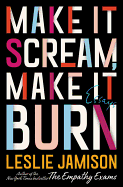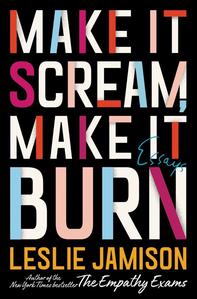
 With the essay collection Make It Scream, Make It Burn, Leslie Jamison confirms the praise heaped on 2014's The Empathy Exams for her uncanny ability to blend perceptive reportage with intensely personal essays in consistently fresh, dynamic prose.
With the essay collection Make It Scream, Make It Burn, Leslie Jamison confirms the praise heaped on 2014's The Empathy Exams for her uncanny ability to blend perceptive reportage with intensely personal essays in consistently fresh, dynamic prose.
Jamison, who directs the graduate nonfiction program at Columbia University, embarks on reporting trips that take her from Sri Lanka to Croatia, and span the United States, from Whidbey Island, Wash., to Charlottesville, Va. The book's subjects are similarly varied, among them a mysterious whale nicknamed "52 Blue" that's somehow become the source of comfort to scores of lonely people; a psychiatrist who studies children who claim to have lived past lives; and the surprisingly enduring computer simulation Second Life, which recognizes that "the impulse to escape our lives is universal."
Two companion pieces shed light both on their ostensible subjects and on Jamison's own approach to her journalistic endeavor. In the title piece, she investigates James Agee and his classic work with photographer Walker Evans, Let Us Now Praise Famous Men, based on the 1936 summer Agee spent with a family of Alabama sharecroppers. Agee's "sui genesis work of sprawling lyric reportage" was, in part, the inspiration for the extraordinary project of California photojournalist Annie Appel, who for more than 30 years repeatedly has embedded herself with an impoverished Mexican family in what Jamison calls a "process of intimate entanglement." Jamison uses these pieces to reflect on how for her the "ethical divide between showing up and coming back loomed large," especially when she compares it to the way Appel's obsessive devotion to a single subject "made me ashamed of the ways I'd written about the lives of others after knowing them for a year, or even a month."
Though pieces of Jamison's personal life are threaded throughout her reporting, the collection concludes with some of the confessional writing that made her memoir The Recovering so revealing. In "Museum of Broken Hearts," she introduces an eccentric institution in Croatia devoted to objects that bring to mind their donors' former loves. Jamison uses the opportunity to explore her perception that "our relationship to the past--even its ruptures and betrayals--is often more vexed, that it holds gravity and repulsion at once" through the prism of her own fraught romantic life. The book's concluding piece, "The Quickening," movingly traces the arc of Jamison's pregnancy and the birth of her first child, juxtaposed against her own past struggle with an eating disorder. In these and all the other essays in this book, Jamison consistently demonstrates her "willingness to look at other lives with grace, even when your own feels like shit." All of her readers are the beneficiaries of that rare gift. --Harvey Freedenberg, freelance reviewer
Shelf Talker: Leslie Jamison interrogates a variety of fascinating subjects, including her own life, in her praiseworthy second essay collection.

